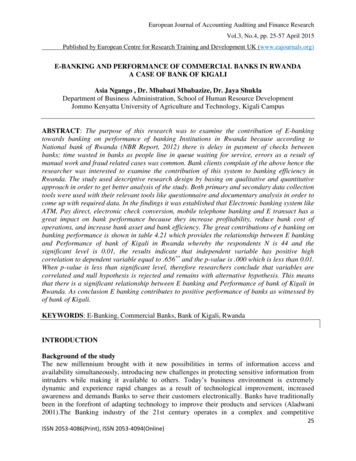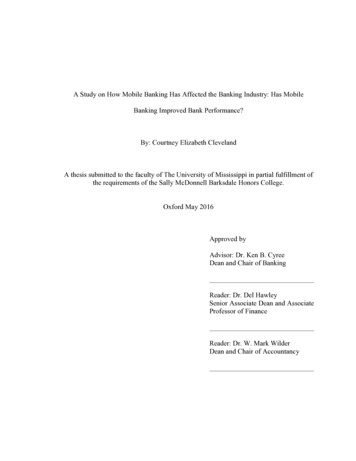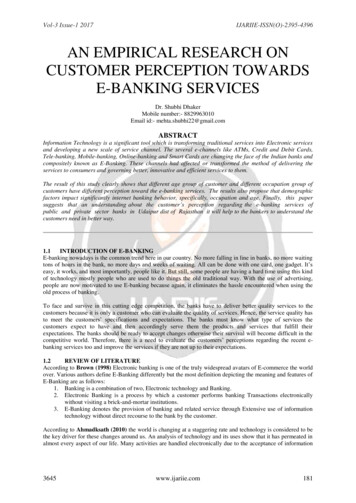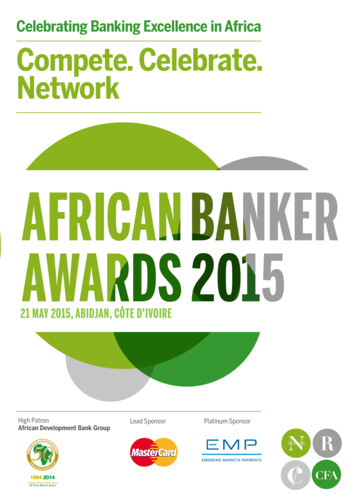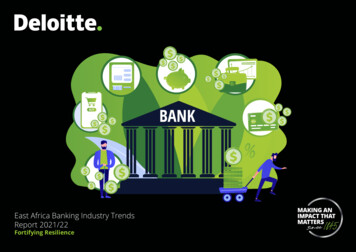
Transcription
East Africa Banking Industry TrendsReport 2021/22Fortifying Resilience
Banking Industry Trends Report 2021/22What to expectIntroduction05Trends07Performance22
East Africa Banking Outlook ReportAbbreviations and AcronymsAIArtificial IntelligenceAPIApplication programming interfaceCBKCentral Bank of KenyaCBRCentral Bank RateCIRCost-to-income ratioCOVID-19 Corona Virus Disease 2019DBSDevelopment Bank of SingaporeEIREffective interest rateERPEnterprise Resource PlanningGDPGross Domestic ProductIoT Internet of ThingsKESKenyan ShillingLIBORLondon InterBank Offered RateNPLNon-performing loanM&A Mergers and acquisitionsSOFR Secured Overnight Funding RateROA Return on Assets3
East Africa Banking Outlook ReportROE Return on EquityRPARobotic process automationRWARobotic process automationTRWATotal Risk Weighted AssetsTZSTanzanian ShillingUBA United Bank of AfricaUGXUgandan ShillingUS United States4
Banking Industry Trends Report 2021/22IntroductionThe banking industry has seen better times. Theemergence of the COVID-19 pandemic has posedsignificant threats and shocks to economies worldwide.In order to remain relevant, banks are being forced torethink how they operate their businesses. Bankerswho have been relying on traditional methods areunder pressure to transform their business andoperating models by adopting innovative digital ways.Prior to COVID-19, the financial services industry wasevolving at a steady pace, driven mainly by changingconsumer expectations, heightened competition,evolving regulations and advancements in technology.Within a short time, COVID-19 has forced radicalchanges in customer behaviour, moving significantportions of the economy online and increasingcustomers’ willingness to engage digitally. The urgencyto get onboard with the digital transformation agendais further stressed upon by the ongoing crisis, asdigitally mature global banking institutions havedisplayed agility and resilience in the immediateaftermath of the crisis.The future of banking involves innovating ways tomake a consumer’s daily life easier. Banks will have tocreate or select the right platforms that bring the mostdistinctive and personalised user experience.From a workplace environment perspective, theexponential use of technology in the bankingenvironment (combined with the dizzying impact ofthe pandemic) has had a dramatic impact on work,the workforce, and the workplace. Going into thefuture of work, these changes in work, workforce,and the workplace are fundamentally shifting howbanking talent needs to be managed. Creating a muchmore dynamic view of work, the workforce, and theworkplace will be key to surviving and thriving.Finally, banks are increasingly considering a risk-basedpricing approach for their loans, linking loan pricesdirectly to the borrowers’ risk profile and past creditbehaviour. This allows banks to optimize revenues fromlending, and reward deserving, financially disciplinedcustomers. On the other hand, this could choke thesupply of credit to certain segments of borrowers asrelatively wealthy customers may have relatively easyaccess to low-cost loans while less well-off borrowersmay not be able to bear the costs of borrowing. Asfor any new approach, risk-based pricing will comewith challenges but the positive implications for bothlenders and borrowers are too powerful to ignore. Theinstitutions that prepare for the shift, by building datacapabilities and pulling together systems to build amore holistic view of customers, will be well positionedto capitalize on the opportunities.5
Banking Industry Trends Report 2021/22The time to start thinking strategically about how topivot during these uncertain times is now, in a waythat not only protects banks’ balance sheets but alsoensures survival.Our Banking Industry Trends Report 2021/22 is basedon the first-hand experience and insights of Deloitte’ssubject matter specialists, and we hope you find itthought provoking as you contemplate your strategicpriorities and adjust your agenda for the year ahead.Please share your feedback or questions with us. Wewelcome the opportunity to discuss our report directlywith you and your team.Charles LuoLeaderDeloitte FinancialInstitutions Services TeamEast Africacluo@deloitte.co.keTimothy MachiraSenior ManagerDeloitte FinancialInstitutions Services TeamEast Africatmachira@deloitte.co.ke6
Banking Industry Key Trends123456Banking Industry PerfomanceBanking Industry’s Key TrendsAs the industry continues to grapple with high cost of doing business and aslowdown in the economy due to the global pandemic, we observe the followingbeing the key trends in the banking industry1 2 3Accelerating DigitalTransformationAs the invasion of digitaltransformation is takingshape, incorporating itinto banks’ customerexperience strategyhas become integral forthriving in this era of digitaldisruption.Strengthening OperationalResilienceThe banking industry isexpected to maintainits focus on operationalresilience while alsoreacting to increasingdemand from regulators,investors, and otherstakeholders for increasedEnvironmental, Social, andCorporate Governance(ESG) reporting.7Recovering Credit LossesRigorous credit lossassessments will assistbanks in better riskassessment and pricingof their credit facilities.In so doing, banks willbe better prepared tomitigate their expectedlosses.
Banking Industry Key Trends123456Banking Industry Perfomance4 5 6Mitigating CyberCrimesThe potential forcyber risk is on therise, with greaterinterconnectedness inthe banking ecosystem,rapid adoption ofnew technologies andcontinued reliance onlegacy infrastructuredesigned for a differentage.Adapting to the EvolvingRegulatory EnvironmentRegulators areexpected to maintainvigilant enforcementprograms and todemand more datafrom banks to test theoperational integrity ofcomplex institutions—especially when understress.8Emergence of InorganicGrowthMost banks will needto reinvent themselvesin order to thrive, andMergers & Acquisitions(M&A) activities areexpected to have astrong influence inshaping the “nextnormal” environment.
Banking Industry Key Trends123456Banking Industry PerfomanceAccelerating DigitalTransformationOverviewAs the invasion of digital transformation is takingshape, incorporating it into banks’ customer experiencestrategy has become integral for thriving in this era ofdigital disruption. Customers are demanding seamless,tailored products and service choices with user-friendlyinterfaces. Therefore, streamlining front-end operationscould be an essential priority. Mobile and online bankingemerged as the top IT priority for nearly half of theglobal corporate banking respondents in an Ovum ICTEnterprise survey. The banking industry received a bigblow when governments encouraged the shift from theconventional cash transactions to electronic money, inorder to curb the spread of the pandemic. This movesaw customers relying heavily on big players in themobile money market like M-Pesa in Kenya, MTN inUganda, Tanzania, and Rwanda, and Tigo in Rwanda.Artificial intelligence (AI) generates an enormousopportunity for the banking sector to understandthe entire consumer footprint and accelerate theirdigital transformation journey. Creating a personalizedexperience with customers is impossible withoutautomation and intelligence.Challenges Faced by BanksThere has been a decline in bank visits with customersopting to deposit cash via mobile money platforms andtransfer bank deposits to their mobile money wallets.This has posed a challenge to banks which have madesignificant investments in brick and mortar.The high cost of investing in new technology and robustdigital systems also poses a significant challenge tobanks that have not considered significantly shifting to adigitized banking environment.In addition, the promise of digital banking has not beenfully realized, largely due to customer reluctance and/ora lack of attractive digital solutions by the banks. Bankshave faced stiff competition from digital players such asM-Pesa, which has weakened their channel power.What Banks have doneGlobally and locally, banks are investing in chatbotsto improve their customers’ experience. Chatbots areAI enabled conversational interfaces used to interactwith customers instantly by replicating the patterns ofhuman conversations. Banks using AI chatbots havebeen able to increase customer interaction and attractmore customers compared to those who do not havethe platform.Several top tier banks in the region have developedcredible and reliable systems that allow their clientsto have a smooth transition into the new operatingmode of a digitized banking environment. Some ofthese systems include Mobile money, Mobile bankingapplications and Online transaction systems.9
Banking Industry Key Trends1234Let’s TalkDaniel Materudamateru@deloitte.co.tzAmaha Bekeleabekele@deloitte.co.ke56Banking Industry PerfomanceDeloitte’s PerspectiveBanks should consider leveraging innovations intechnology such as cloud platforms, analyticalcapabilities, and augmented intelligence whichcan generate levels of customer engagementand operational efficiency that were unthinkablebefore. CBK’s governor recently noted thatcloud platforms present a great opportunity forfinancial institutions to upscale to cutting edgefinancial services platforms to meet the needsof today’s discerning customers. Further to this,advancement in biometric technology includingfacial recognition is creating new opportunities forbanks to streamline their customer experience.Currently, the facial recognition technology isoperational in many smartphones and banks cancapitalize on the already inbuilt and integratedsoftware.Exploitation of these digital platforms shouldenable banks to cross-sell services to customersmore efficiently, potentially increasing banks’revenue streams. For instance, banks that pooldata from different sources should enable salespersonnel to leverage on this data via digitalinterface as they engage with clients. Digitaltools with cross-business data could allow juniorbankers to work directly with customers withoutrelying on the relationships of senior bankers,while eliminating multiple roles in service delivery,all of which would reduce operating expenses andenhance customer centricity.By forming partnerships or linking with third partyecosystems, banks can provide a better customer10experience and can evaluate customers past theboundaries of their traditional interactions.Banks should prioritize retaining first-time usersof digital channels by using targeted offersand engagement strategies. At the same time,they should invest in digital, customer-facingtechnology to provide the seamless experiencethe industry has been seeking for a while. Theseenhancements may not only cover digital-onlychannels but also in-branch experiences, such asself-service digital kiosks/interfaces.Banks should also focus on delivering hyperpersonalized services that can factor in acustomer’s financial well-being holistically, byintegrating their disparate data architectureacross lines of business and functions andcombine it with AI-driven analysis to create a360-degree view of customers.There should also be increased implementationof chatbots and conversational AI tools to assistBanks engage their customers more, given theimpact of the pandemic which has acceleratedthe reduction in branch transactions.Finally, although digital interfaces are essentialand desired, some customers tend to needperson-to-person experiences to boost loyalty.Therefore, banks should be sure to maintain thehuman touch.
Banking Industry Key Trends123456Banking Industry PerfomanceStrengtheningOperational ResilienceOverviewOperational resilience is a foundational componentof an organization’s operational risk managementframework. It enables organizations to proactivelyrespond to (and recover from) operational disruptionsto the business, industry, and customers. COVID-19inflicted enormous stress on banks’ operations, andthere have been hiccups at some institutions, but manybanks have handled the challenges well. Overall, therelatively smooth transition to a new virtual operatingmodel is a testament to years of preparation andregulators’ attention on operational resilience. Thepandemic also highlighted the need for greater rigorin some banks’ business continuity planning, crisismanagement, and recovery. Moreover, it has exposedvulnerabilities in their global footprint and dependenceon external provider networks; in countries observingnational lockdowns, many institutions experienced adisruption in offshore delivery centres.The exponential use of technology in the bankingenvironment combined with the dizzying impact ofthe pandemic had a dramatic impact on work, theworkforce, and the workplace. Going into the future ofwork, changes in work, workforce, and the workplacehave fundamentally shifted how banking talent needsto be managed to achieve an optimal organizationstructure. Creating a much more dynamic view of work,the workforce, and workplace will be key to surviving,thriving and achieving an optimal organizationstructure.Banks and other financial institutions are also facingincreased demand from regulators, investors, andother stakeholders for enhanced Environmental,Social and Corporate Governance (ESG) reporting. ESGreporting is becoming more critical as sustainabilitybecomes ever more important. Banks will needto increasingly consider the sustainability of theiroperations from an environmental and socialimpact perspective, as well as the operations of theinstitutions they lend to.Challenges Faced by BanksAs banks grapple with lower top-line revenues,increased demand for digital offerings, need for revisedCyber security measures, adjustments to working ina post-pandemic era as well as traditional operationalcosts, banks now face a new challenge of revising theircost management strategies in a highly competitive,post-pandemic global economy.Social distancing and long-term remote working haveposed new business continuity difficulties that werepreviously unimaginable. Ensuring business continuityamidst the economic turmoil brought about by thepandemic has been a major challenge for banks.11
Banking Industry Key TrendsBanking Industry PerfomanceGraph 1: Source - Central Bank of Kenya ReportsProfit Before 00400300200100-Q6220195Q4120193Q2USD Millions1“Banks will need toincreasingly considerthe sustainability oftheir operations from anenvironmental and socialimpact perspective, aswell as the operations ofthe institutions they lendto.”From a regulatory front, the recent push intofinancial services operational resilience is the closestregulators have yet come to scrutinising how a firmdesigns its internal operations. Banks must learn tolive with continuous and rising regulatory scrutiny ofthe resilience of their operations. Financial servicesoperating models will have to adapt to this reality.What Banks have doneBanks have ensured they have adequate liquidity,evidenced by the increase in the Kenyan BankingIndustry average liquidity ratio from 49.7% in December2019 to 54.5% in December 2020, whereas the UgandanBanking Industry liquidity ratio increased from 48.6% inDecember 2019 to 50.7% in December 2020.Banks have also found it challenging sustainingemployees’ workload, accelerating digital efforts andbalancing resources, often resulting in the constantlychanging and increasingly complex work requirementsnot being prioritized and addressed accordingly.Banks have also suspended some of their expendituresas part of structural cost transformation initiatives tobolster operational efficiency.Banks’ operating models also need to respond to newtrends in the business environment as countries emergefrom the COVID-19 pandemic. They cannot simply goback to the status quo ante operating models of early2020.12Despite the enormous stress on banks’ profitabilityinflicted by the pandemic, there is a possible reboundin profit growth in 2021 as compared to the profit levelsin 2020. As shown in graph 1, the Kenyan BankingIndustry quarterly profit before tax increased betweenDecember 2020 and March 2021, owing to a lowerdecrease in income compared to decrease in expenses.
Banking Industry Key Trends123456Banking Industry PerfomanceFigure 1: Source – Deloitte, Resilience Reimagined: A PracticalGuide for OrganizationsDiscuss entialOutcomesDefine ImpactThresholdsBalanceStrategicChoicesStress TestThresholdsEnable Adaptive LeadershipDiscuss future failureto avoid complacencyand instil ‘futuresthinking’. Ask what if?Ask what next?Encourage your peopleto speak up.Consider theconnection betweenall components of theecosystem tounderstand thepotential impact ofdisruption on yourstakeholders, yourorganization and onwider society.Understand what isimportant to yourstakeholders and tosociety, the essentialoutcomes that requirea higher degree ofresilienceSet impact thresholdsfor essential outcomesto determine tolerablelimits that should notbe breached,considering the impacton all components ofthe ecosystem.Make strategicchoices aboutresilience interventionsby balancing control,agility, efficiency andinnovation.Conduct stresstesting to determinewhether you are ableto remain within yourimpact thresholdsirrespective of thethreat.Deloitte’s PerspectiveBanks should make a shared corporate cultureand understanding a top priority. They shouldalso establish improved practices across thepeople, processes, governance and technologydomains using a multidimensional operationalresilience framework as a guide.Undoubtedly, agility goes hand in hand withresilience. Banks should avoid perfection infavour of agile execution. Leaders shouldempower their front-line workforces with moredecision-making authority by creating flatter teamstructures and revisiting responsibilities andaccountability.Banks should also pursue a structural costtransformation initiative to bolster operationalefficiency. They should invest significantlyinto their Enterprise Resource Planning (ERP)systems and other tools to achieve greater costtransparency and leverage insights from analyticsreports to design better profitability strategies.They can also use branch and office spacerationalization as one of the levers to lower fixedcosts.Banks should continue to explore howtechnologies such as cloud, machine learning,robotic process automation and distributedledger technology can simultaneously contributeto significant cost savings while helping increasespeed, improve accuracy, and provide scalability.Streamlining front-to-back data flows and13deploying data analytics will remain prerequisitesto achieve the desired efficiencies. It is time fororganizations to look at ways of shaping businessculture to fully leverage digital technologies and tounlock new opportunities.Building resilience cannot be considered aone-time effort, and bank executives muststrive to establish a dynamic resilience strategyand continually redesign, iterate, recreate, anddevelop resilience. According to a researchconducted by Cranfield University in Partnershipwith Deloitte, seven future practices wereidentified which form a resilience methodologyfor organizations (figure 1). Banks may chooseto focus their efforts on a specific practiceor practices but should be mindful of theimplications on an adjacent practice in the model.Finally, Banks will need to integrate ESG factors intheir operational, lending and risk managementstrategies. This will enhance their long-termvalue creation and open up opportunities fordevelopment of new sustainable banking andinvestment products.Let’s TalkGeorge Hapisughapisu@deloitte.co.keLillian Lwantalellwantale@deloitte.co.ug
Banking Industry Key Trends123456Banking Industry PerfomanceRecovering Credit LossesOverviewBanks in East Africa have experienced a reduction inclient transactions and amounts in bank collectionaccounts (for example, collection accounts for rent)as businesses faced a downtime in operations. Thisdirectly translated to a reduction in the amountof funds available for banks to invest and lend.Hence most banks have diversified their incomestreams. Additional services offered in banks includebancassurance, letters of credit and guarantee,agency banking, and custodial and merchant services.Although all income streams have shown a significantdecline in amounts of revenue collected in terms ofcommission, banks that offered these services werebetter cushioned against large losses compared tobanks that did not provide for these services.Challenges Faced by BanksOne significant challenge faced by banks is theincrease in the number of Non-Performing Loans(NPLs). Layoffs, salary cuts, low demand and lowpurchasing power means collaterals such as vehiclesare not easy to dispose, and banks may ultimately beunable to cover their losses in the event of a default.As can be seen in graph 2 below, the NPL ratio for theKenyan and Ugandan banking industry have been ona gradual increase between 2018 and the first quarterof 2021.Another key dilemma banks face is whether tocontinue financing businesses that have experiencedcash flow challenges to allow for their survival duringGraph 2: Source - Central Bank of Kenya, Bank of UgandaNPL Ratio 20192020Q12021Ugandathis uncertain period, or stop financing based on theincreased probability of default of these businesses.The latter option may lead to the eventual closure ofthese businesses and ultimately end up as bad debtsin the bank’s loan books.What Banks have doneThe short-term environment is very uncertain.Industries such as hospitality, tourism and transporthad immediate adverse effects that saw the closureof hotels, tours and travel companies and airlines.Consequently, banks have generally been sceptical ofissuing any short-term loans secured by salary with adark gloom over the economy, and preferred issuinglong-term loan facilities that are more stable.Clients affected by the pandemic, after negotiations14
Banking Industry Key Trends123456with their banks, were able to restructure theirloans, allowing them to pay the amount they couldafford. Most restructures included a change in therepayment amount, allowances for no principalpayments, no interest payments, or no paymentsfor both principal or interest for a duration of time.The loan duration was also amended in line withthe change in repayments. The impact was that thebanks could retain their clients into their loan books,hence securing their income position. In addition, theywere able to help their clients continue running theirbusinesses despite their local economic strain.Banking Industry PerfomanceDeloitte’s PerspectiveThe credit risk models used by many banks were not developed to accommodate the extreme economicconditions and the levels of government support measures being introduced. The inclusion of more extremeeconomic inputs may identify issues with the sensitivity and calibration of existing models. Thus, entitiesmay find that additional model development is required for banks to accurately predict their expected creditlosses and make subsequent allowances for them. These new assumptions and risk assessments shouldbe more directly embedded into stress-testing exercises. This rigorous credit losses assessment will alsoassist banks in better risk assessment and pricing of their credit facilities. In so doing, banks will be betterprepared to mitigate their expected losses.In addition, regular monitoring of loan performance by clients is essential in determining the trend of clients’behaviour. This will allow banks to predict defaults early and set up mitigation procedures such as reductionof overdraft amounts or funding more where business require additional capital despite overall marketperformance.Banks need to rethink old governance models and the way they are applied. They should prioritize a riskmanagement approach that is holistic, all-encompassing, and embedded across the business to ensure aresilient foundation in the long term.Finally, banks need to assess which sectors/clients are most at risk of defaulting and re-examine loan lossprovisions under different economic scenarios. Banks also need to reach out to clients with communicationsand information requests to provide temporary help as appropriate.“Most restructures included a changein the repayment amount, allowancesfor no principal payments, no interestpayments, or no payments for bothprincipal or interest for a duration oftime.”15Let’s TalkCharles Luocluo@deloitte.co.keTimothy Machiratmachira@deloitte.co.ke
Banking Industry Key Trends123456Banking Industry PerfomanceMitigating the Rise ofCyber CrimesOverviewThe potential for cyber risk has been increasing withgreater interconnectedness in the banking ecosystem,rapid adoption of new technologies and continuedreliance on legacy infrastructure designed for adifferent age. According to the global Deloitte 2021Banking and Capital Markets Outlook, the financialservices sector is more likely than other industriesto be a victim of hackers, with many institutionsincreasingly naming cybersecurity as the mostimportant risk type. This risk is now of top concern forfinancial services risk managers. Cyberattacks haveindicated a need for many banks to understand theirecosystem and the inherent vulnerabilities that existwithin their networks.Challenges Faced by BanksCyber risk is only getting more complex, and in waysthat are not fully understood and predictable. Thereis more to be done to make sure that cyber risk isincorporated into the bank’s operations ahead oftime, as opposed to after risk occurrence. This beginswith building a robust culture of due care acrossthe organization and ensuring that cyber securityis a key consideration in the design of businessprocesses, strategy, and innovation. Additionally thedata protections regulations in Kenya and Ugandahas increased the focus on cyber security controls toprotect data held by Banks.This focus on cyber risk as a critical element inalmost every aspect of business increases the cyberawareness and helps them in timely identification ofrisk elements. This will have numerous benefits suchas the ability to improve speed to market and makeorganizations more resilient and responsive to marketneeds, which is the very definition of agility.The pandemic has tested the cyber resilience ofbanks, as the virtual/distributed work model becamethe norm. This has not only increased the perimetersof the Bank, but also enhanced the surface area forcyber attackers. There was an enormous increase inthe number of attacks that Banks faced during thisperiod. Insider risk is also increasing because of thepsychological stress employees are likely to face as thepandemic continues.Due to the complex nature of cyber risk, handling themrequires specialized talent. Availability of trained andexperienced professionals in the local market has beena significant challenge for organizations. As a resultof this, some organizations are unable to correctlyidentify, manage and be resilient to cyber risk.Staying ahead of changing business needs andaddressing threats from increasingly moresophisticated attacks are top challenges for executives.Further, third-party relationships with externaltechnology vendors, suppliers, or service providerscould expose banks to information misuse and theft(insider risk), system failures and business disruptions(operational risk) and/or regulatory non-compliance.Finally, technical debt, or the lack of legacy systemmodernization, remains a significant challenge inmaking the enterprise more secure.16
Banking Industry Key Trends123456Banking Industry PerfomanceWhat Banks have doneRelatively few banks have recognized organizedcyber-criminal networks, rather than hackers, as theirgreatest potential cyber security threat; even fewer areprepared to address this threat.Banks tend to employ security-based “wall-andfortress” approaches such as increasing fundinggeared towards enhancing their security systems andprotocols and recruiting specialized talent into theircyber security units to address the threat of cybercrime.There is greater cooperation among banks,counterparties, and regulators, including sharing ofinformation and best practices.Deloitte’s PerspectiveBank leaders should rethink traditionalcybersecurity measures that may still be inplace considering these factors. Fully leveraginginterbank alliances might help strengthen banks’defence against these threats. Banks shouldadopt a “security by design” approach, wherecybersecurity is strategically integrated into theentire business process and into standard codedevelopment.They should also reassess how they deploy theircybersecurity budgets because higher spendingdoes not always yield better outcomes. Someof the most mature programs in the industryattribute their success to improving governanceby involving senior leadership in the journey,raising cybersecurity’s profile to an enterprisewide responsibility, putting cybersecurity at17the centre of digital transformation efforts, andaligning cybersecurity efforts with their strategyand daily operations.In addition, banks should also use user behavioranalytics and machine learning to further helpdetect potential anomalous behavior on thenetwork and individual endpoints.Banking institutions should also adopt moreeffective preventative controls as well as preparefor rapid recovery from adverse events causedby malware, ransomware, and other perniciousattacks. Banks should also develop robust CyberIncident and Response Plans that takes intoconsideration various risk they are exposed to andthe security technologies they have implemented.These plans should be tested frequently to makesure that it is able to handle cyber incidents.Finally, banks should enhance data securit
Banking Industry Key Trends 7 As the industry continues to grapple with high cost of doing business and a slowdown in the economy due to the global pandemic, we observe the following being the key trends in the banking industry Banking Industry's Key Trends 1 As the invasion of digital transformation is taking shape, incorporating it
